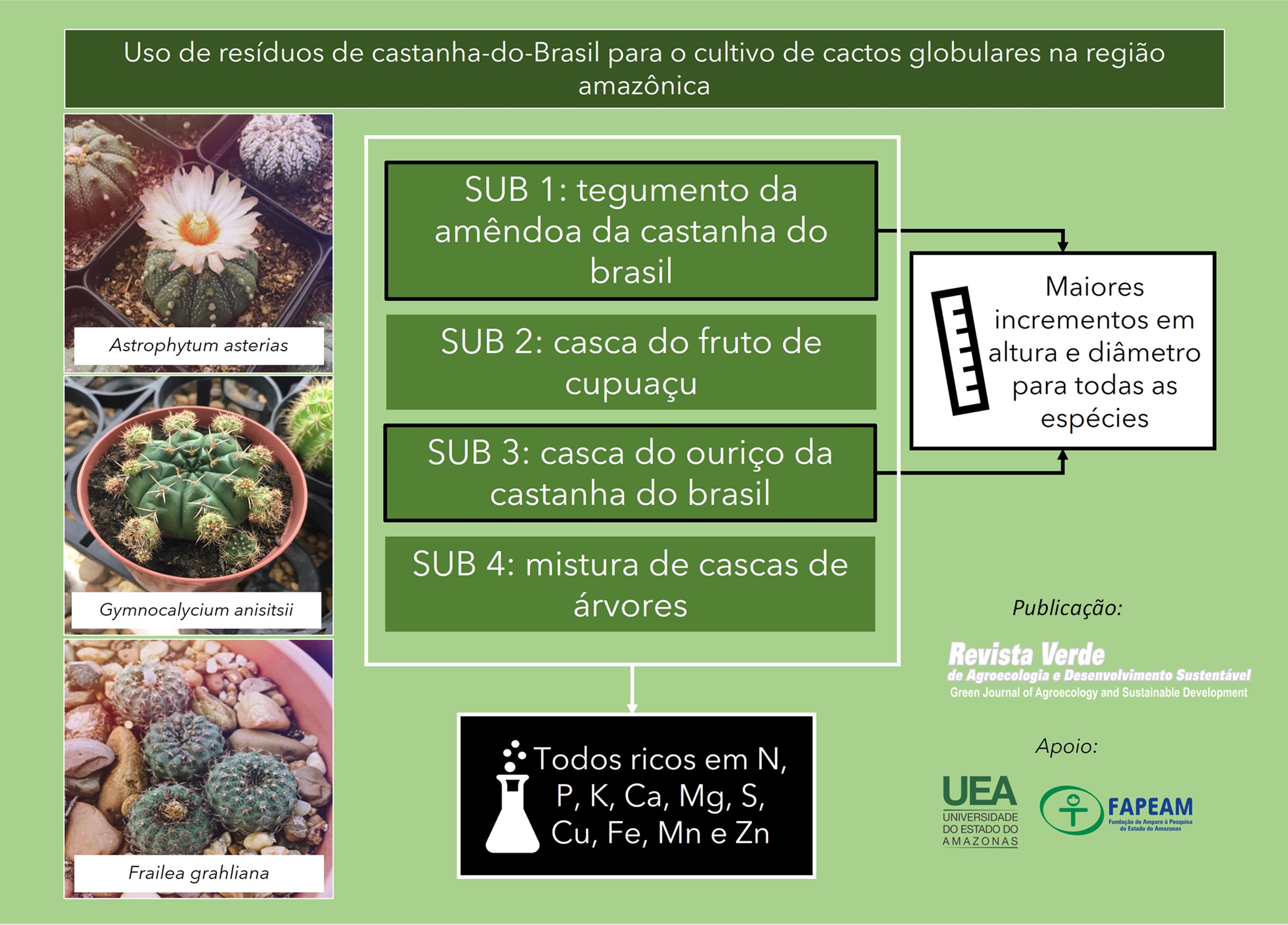Use of Brasil nut residues for globular cacti cultivation in the Amazon region
DOI:
https://doi.org/10.18378/rvads.v17i3.9333Keywords:
Astrophytum, Gymnocalycium, Frailea, Cactaceae, SubstrateAbstract
This research aimed to evaluate growth responses of three globular cacti species: Astrophytum asterias (Zucc.) Lem., Gymnocalycium anisitsii subsp. multiproliferum (P.J. Braun) P.J. Braun & Esteves e Frailea grahliana (F. Haage) Britton & Rosee cultivated in four organic substrates. The species were chosen based in their comercial value and availability of acquisition. The experimental design used was completely randomized, with 15 individuals of each species per treatment, as follows: SUB 1 (brazilian nut crushed seed coat), SUB 2 (cupuaçu fruit chushed bark), SUB 3 (brazilian nut crushed fruit bark) and SUB 4 (mixed tree barks chushed). Chemical anlysis of each material revealed importante diferences in pH values. The brazilian nut crushed seed coat provided the best results in height and diameter incremente for all species tested, being the most suitable material for use, both pure or added to Other materials in media composition recipes. Considering the physical properties and nutritional contentes, all materials have potential to be used as media to the tested species, however, it is recommended to use the cupuaçu bark and the mixed tree barks with Other componentes so that the pH can be balanced.
Downloads
References
BIRNBAUM, S. J.; POOLE, J. M.; WILLIAMSON, P. S. Reintroduction of star cactus Astrophytum asterias by seed sowing and seedling transplanting, Las Estrellas Preserve, Texas, USA. Conservation Evidence 8:43–52, 2011.
CALHOUN, S. The gardener´s guide to cactus: the 100 best padles, barrels, columns and globes. Timber Press, 2012.
CUNHA, A. M.; CUNHA, G. M.; SARMENTO, R. A.; CUNHA, G. M.; AMARAL, J. F. T. Efeito De diferentes substratos sobre o desenvolvimento de mudas de Acacia sp.. Revista Árvore. v.30, n.2, p. 207-214, 2006. https://doi.org/10.1590/S0100-67622006000200007
DIAS, J. M. C. de S.; SANTOS, D. T. dos; BRAGA, M.; ONOYAMA, M. M.; MIRANDA, C. H. B.; BARBOSA, P. F. D.; ROCHA, J. D. Produção de briquetes e péletes a partir de resíduos agrícolas, agroindustriais e florestais. Brasília, DF: Embrapa Agroenergia, 2012. 130 p.
DOS ANJOS, D. B.; RIBEIRO, C. F.; NUNES, T. A.; SILVA, J. Potencial da casca da castanha do Brasil como biofertilizante no cultivo de Lactuca sativa. South American Journal of Basic Education, Technical and Technological, v.4, n.1, p.193-199, 2017.
FARIAS, A. P.; ALBUQUERQUE, A. W.; FILHO, G. M.; REIS, L. S. Produtividade da Heliconia psittacorum x Heliconia pathocircinada cv. Golden Torch sob diferentes fontes de adubação orgânica. Revista Brasileira de Engenharia Agrícola e Ambiental v.17, n.7, p.713–720, 2013.
FERREIRA, R. R. M.; TAVARES FILHO, J.; FERREIRA, V. M. Efeitos de Sistemas de Manejo de Pastagens nas Propriedades Físicas do Solo. Semina: Ciências Agrárias, v.31, n.4, p.913-932, 2010.
IBRAFLOR – Instituto Brasileiro de Floricultura. Números do Setor – Mercado Interno – 2020. Disponível em: <https://www.ibraflor.com.br/ibraflor1>. Acesso em: 12 de março de 2022.
KÄMPF, A.N. Produção comercial de plantas ornamentais. Guaíba: Agrolivros, 2005, 256p, 2008.
KÖPPEN, W. Grundriss der Klimakunde. Berlim: Walter de Gruyter, 1931. 390p.
LOPES, J. L. W.; GUERRINO, I. A.; SAAD, J. C. C.; SILVA, M. R. Atributos químicos e físicos de dois substratos para produção de mudas de eucalipto. Cerne, v. 14, n. 4, p. 358-367. 2008.
LORENZI, H; OLSTHOORN, G; COSTA, C. Cactos e outras suculentas para decoração. Nova Odessa-São Paulo: Jardim Botanico Plantarum, 2019.
MENDES, R. F.; ARAÚJO, J. C.; ANDRADE NETO, R. de C.; ARAÚJO, J. M.; GUILHERME, J. P. M. Crescimento de mudas de maracujazeiro em substrato alternativo com fertilizante de liberação controlada. Revista Brasileira de Agropecuária Sustentável, v.9, n. 4, p.34–40, 2019.
PRADO, R. M. Nutrição de plantas. 2. Ed. São Paulo: Unesp, 2020.
SANTOS, J. P.; BRAGA, L. F.; RUEDELL, C. M.; JÚNIOR, G. D. F. S.; FERBONINK, G. F.; CAIONE, G. Caracterização física de substratos contendo resíduos de cascas de amêndoas de castanha-do-brasil (Bertholletia excelsa HBK). Revista de Ciências Ambientais, v. 12, n. 2, p.07-17, 2018. https://doi.org/10.18316/rca.v12i2.2738
SCHMITZ, J.; SOUZA, P. V. D.; KÄMPF, A. N. Propriedades químicas e físicas de substratos de origem mineral e orgânica para o cultivo de mudas em recipientes. Ciência Rural v. 32 p. 937-944, 2002. https://doi.org/10.1590/S0103-84782002000600005
TAKANE, R. J; PIVETTA, K. F. L; YANAGISAWA, S. S. Cultivo técnico de cactos e suculentas ornamentais.1. ed. Fortaleza: GrafHouse, 2009.

Downloads
Published
How to Cite
Issue
Section
License
Copyright (c) 2022 Iane Barroncas Gomes et al.

This work is licensed under a Creative Commons Attribution 4.0 International License.










